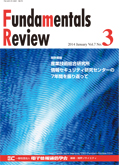Volume 7, Issue 3
Displaying 1-23 of 23 articles from this issue
- |<
- <
- 1
- >
- >|
Cover
-
2014Volume 7Issue 3 Pages 7_0-
Published: 2014
Released on J-STAGE: January 01, 2014
Download PDF (248K) -
2014Volume 7Issue 3 Pages 7_163-
Published: January 01, 2014
Released on J-STAGE: January 01, 2014
Download PDF (137K)
Preface
-
2014Volume 7Issue 3 Pages 164-165
Published: January 01, 2014
Released on J-STAGE: January 01, 2014
Download PDF (332K)
Special Contribution
-
2014Volume 7Issue 3 Pages 166-171
Published: January 01, 2014
Released on J-STAGE: January 01, 2014
Download PDF (638K)
Origins of Technology
-
2014Volume 7Issue 3 Pages 172-185
Published: January 01, 2014
Released on J-STAGE: January 01, 2014
Download PDF (6962K)
Review Papers
Proposed by SIP
-
2014Volume 7Issue 3 Pages 186-196
Published: January 01, 2014
Released on J-STAGE: January 01, 2014
Download PDF (1721K)
Proposed by VLD
-
2014Volume 7Issue 3 Pages 197-209
Published: January 01, 2014
Released on J-STAGE: January 01, 2014
Download PDF (3323K)
Proposed by SITE
-
2014Volume 7Issue 3 Pages 210-226
Published: January 01, 2014
Released on J-STAGE: January 01, 2014
Download PDF (1689K)
Proposed by IT
-
2014Volume 7Issue 3 Pages 227-241
Published: January 01, 2014
Released on J-STAGE: January 01, 2014
Download PDF (1709K)
Proposed by IMQ
-
2013Volume 7Issue 3 Pages 242-248
Published: January 01, 2014
Released on J-STAGE: January 01, 2014
Download PDF (1742K)
Proposed by US
-
2014Volume 7Issue 3 Pages 249-255
Published: January 01, 2014
Released on J-STAGE: January 01, 2014
Download PDF (1385K)
Proposed by Editorial Committee
-
2014Volume 7Issue 3 Pages 256-268
Published: January 01, 2014
Released on J-STAGE: January 01, 2014
Download PDF (4134K)
Miscellaneous Articles
ESS News
-
2014Volume 7Issue 3 Pages 269
Published: January 01, 2014
Released on J-STAGE: January 01, 2014
Download PDF (118K)
International Conference Report
-
2014Volume 7Issue 3 Pages 270-271
Published: January 01, 2014
Released on J-STAGE: January 01, 2014
Download PDF (481K) -
2014Volume 7Issue 3 Pages 272-273
Published: January 01, 2014
Released on J-STAGE: January 01, 2014
Download PDF (400K)
Let's go to IEICE Workshops!
-
2014Volume 7Issue 3 Pages 274-275
Published: January 01, 2014
Released on J-STAGE: January 01, 2014
Download PDF (834K) -
2014Volume 7Issue 3 Pages 275-276
Published: January 01, 2014
Released on J-STAGE: January 01, 2014
Download PDF (1148K)
Winners' Voice
-
2014Volume 7Issue 3 Pages 277-284
Published: January 01, 2014
Released on J-STAGE: January 01, 2014
Download PDF (4979K)
Nakano Report
-
2014Volume 7Issue 3 Pages 285-286
Published: January 01, 2014
Released on J-STAGE: January 01, 2014
Download PDF (1504K)
Antwerp Report
-
2014Volume 7Issue 3 Pages 287-289
Published: January 01, 2014
Released on J-STAGE: January 01, 2014
Download PDF (1405K)
Niigata Report
-
2014Volume 7Issue 3 Pages 290-291
Published: January 01, 2014
Released on J-STAGE: January 01, 2014
Download PDF (428K)
Call for Papers
-
2014Volume 7Issue 3 Pages 292-294
Published: January 01, 2014
Released on J-STAGE: January 01, 2014
Download PDF (1409K)
Committees & Editors Notes
-
2014Volume 7Issue 3 Pages 295-297
Published: January 01, 2014
Released on J-STAGE: January 01, 2014
Download PDF (359K)
- |<
- <
- 1
- >
- >|
